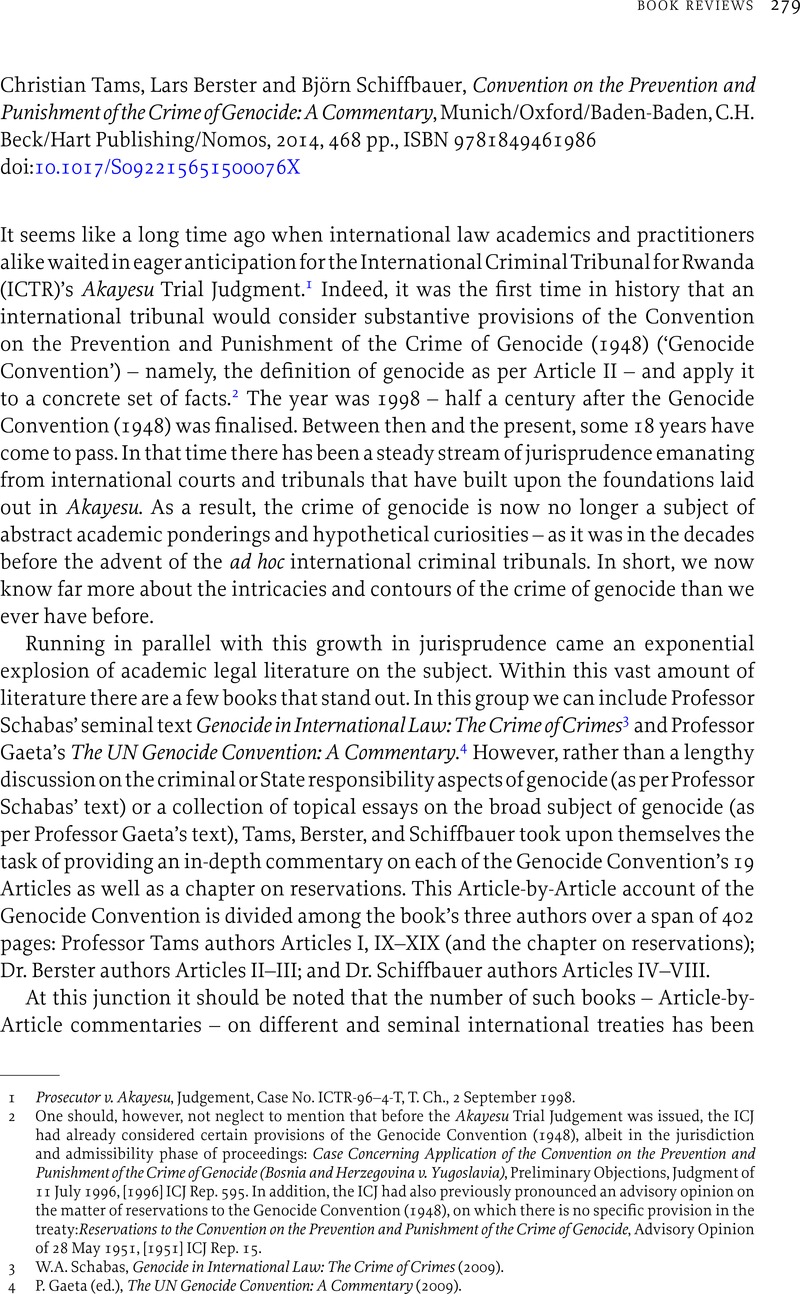No CrossRef data available.
Published online by Cambridge University Press: 01 February 2016

1 Prosecutor v. Akayesu, Judgement, Case No. ICTR-96–4-T, T. Ch., 2 September 1998.
2 One should, however, not neglect to mention that before the Akayesu Trial Judgement was issued, the ICJ had already considered certain provisions of the Genocide Convention (1948), albeit in the jurisdiction and admissibility phase of proceedings: Case Concerning Application of the Convention on the Prevention and Punishment of the Crime of Genocide (Bosnia and Herzegovina v. Yugoslavia), Preliminary Objections, Judgment of 11 July 1996, [1996] ICJ Rep. 595. In addition, the ICJ had also previously pronounced an advisory opinion on the matter of reservations to the Genocide Convention (1948), on which there is no specific provision in the treaty:Reservations to the Convention on the Prevention and Punishment of the Crime of Genocide, Advisory Opinion of 28 May 1951, [1951] ICJ Rep. 15.
3 W.A. Schabas, Genocide in International Law: The Crime of Crimes (2009).
4 P. Gaeta (ed.), The UN Genocide Convention: A Commentary (2009).
5 See M.E. Villiger, Commentary on the 1969 Vienna Convention on the Law of Treaties (2009); O. Dörr and K. Schmalenbach (eds), Vienna Convention on the Law of Treaties: A Commentary (2012).
6 See B. Simma, D. Khan, G. Nolter and A. Paulus (eds), The Charter of the United Nations: A Commentary (2012).
7 See A. Zimmermann, K. Oellers-Frahm, C. Tomuschat, and C.J. Tams (eds), The Statute of the International Court of Justice: A Commentary (2012).
8 See. W.A. Schabas, The International Criminal Court: A Commentary on the Rome Statute (2012); O. Triffterer and K. Ambos (eds), The Rome Statute of the International Criminal Court: A Commentary, 3rd Edition (2016).
9 See Reservations to the Convention on the Prevention and Punishment of the Crime of Genocide, Advisory Opinion of 28 May 1951, [1951] ICJ Rep. 15.
10 Case Concerning Application of the Convention on the Prevention and Punishment of the Crime of Genocide (Bosnia and Herzegovina v. Serbia and Montenegro), Merits, Judgment of 26 February 2007, [2007] ICJ Rep. 43, para. 429.
11 See Case Concerning Application of the Convention on the Prevention and Punishment of the Crime of Genocide (Croatia v. Serbia), Merits, Judgment of 3 February 2015, para. 95 (emphasis added):
[T]he obligation to prevent genocide can be applicable only to acts that might occur after the Convention has entered into force for the State in question. Nothing in the text of the Genocide Convention or the travaux préparatoires suggests a different conclusion. Nor does the fact that the Convention was intended to confirm obligations that already existed in customary international law.
12 See Supreme Court of the Netherlands, Stichting Mothers of Srebrenica and Others v. The Netherlands and the United Nations, ECLI:NL:HR:2012:BW1999, ILDC 1760 (NL 2012), 13 April 2012; ECtHR – Third Section, Stichting Mothers of Srebrenica and Others v. The Netherlands, Admissibility, Application No. 65542/12, 11 June 2013. The Netherlands was being sued because it was a Dutch battalion (Dutchbat) that had been stationed in Srebrenica under the UN flag in order to protect the civilian population in July 1995. For a further discussion of the implications of this case for the use of force and humanitarian intervention, see Ventura, M.J., ‘The Prevention of Genocide as a Jus Cogens Norm? A Formula for Lawful Humanitarian Intervention’, in Jalloh, C.C. and Elias, O. (eds), Shielding Humanity: Essays in International Law in Honour of Judge Abdul G. Koroma (2015), 289CrossRefGoogle Scholar. When the case returned to the Dutch courts after having lost before the ECtHR, the plaintiffs argued that The Netherlands (since holding the UN liable was no longer possible) had failed to, inter alia, prevent genocide under the Genocide Convention (1948) and sought a declaratory judgment to that effect. The Hague District Court held that this provision only applied between States and did not create an individual cause of action in The Netherlands absent its implementation into Dutch law by parliament. In short, Art. I of the Genocide Convention (1948) was not self-executing. It was held that this was equally true of jus cogens rules. See The Hague District Court of The Netherlands, Stichting Mothers of Srebrenica and Others v. The Netherlands and the United Nations, ECLI:NL:RBDHA:2014:8748, 16 July 2014, paras 4.162–4.165.
13 See Germany, Bundesverfassungsgericht (Federal Constitutional Court), Jorgić, 2 BvR 1290/99, Absatz- Nr. (1–49), 12 December 2000; ECtHR – Fifth Section, Jorgić v. Germany, Application No. 74613/01, 12 July 2007.
14 See Art. X, 1948 Convention on the Prevention and Punishment of the Crime of Genocide, 78 UNTS 277.
15 Namely, Albania, Belgium, Bosnia and Herzegovina, Bulgaria, Canada, Czech Republic, Denmark, Estonia, Fiji, Finland, Georgia, Germany, Ghana, Hungary, Latvia, Luxembourg, Mali, Malta, Montenegro, The Netherlands, Nicaragua, Peru, Poland, Romania, Russia, Rwanda, Switzerland, Ukraine, and the United States of America.
16 See D.L. Nersessian, Genocide and Political Groups (2010), 267–324 (where the author does this over two appendices and five tables).